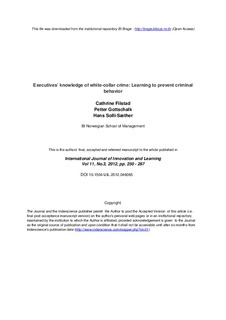Executive's knowledge of white-collar crime: Learning to prevent criminal behavior
| dc.contributor.author | Filstad, Cathrine | |
| dc.contributor.author | Gottschalk, Petter | |
| dc.contributor.author | Solli-Sæther, Hans | |
| dc.date.accessioned | 2013-03-07T09:00:22Z | |
| dc.date.available | 2013-03-07T09:00:22Z | |
| dc.date.issued | 2012 | |
| dc.identifier.issn | 1471-8197 (Print) | |
| dc.identifier.issn | 1741-8089 (Online) | |
| dc.identifier.uri | http://hdl.handle.net/11250/93802 | |
| dc.description | This is the author's final and acceptet version of the article, post refereeing. Publisher's version is available at http://www.inderscience.com | no_NO |
| dc.description.abstract | The purpose of this empirical study was to create insights into executives´ knowledge of white-collar crime and how they can prevent criminal behavior in business organizations. That involves mapping their perceptions of magnitude, attitude, risks and offenders. Our research was carried out by a web-based questionnaire combined with a letter to the largest business organizations in Norway. In terms of risk, respondents suggest that probability of white-collar crime is low, while consequences when occurring are substantial. Most likely position category for white-collar crime is a purchasing manager, followed by a marketing manager, and a person in executive management. External and internal control authorities need to focus less on routines and regulations and more on persons in vulnerable positions. This is how criminal behavior can be prevented. Both descriptive statistics as well as correlation analysis in this paper provide new insights into the extent of white-collar crime, as well as attitudes, risks and vulnerable positions for white-collar crime. Concerning executives own knowledge, they claim to be more competent in discovering, and thus preventing, white-collar crime. They also claim an increased police competence. | no_NO |
| dc.language.iso | eng | no_NO |
| dc.publisher | InderScience | no_NO |
| dc.subject | Financial crime | no_NO |
| dc.subject | White-collar crime | no_NO |
| dc.subject | Survey research | no_NO |
| dc.subject | Learning | no_NO |
| dc.subject | Knowledge | no_NO |
| dc.title | Executive's knowledge of white-collar crime: Learning to prevent criminal behavior | no_NO |
| dc.type | Journal article | no_NO |
| dc.type | Peer reviewed | no_NO |
| dc.source.pagenumber | 250-267 | no_NO |
| dc.source.volume | 11 | no_NO |
| dc.source.journal | International Journal of Innovation and Learning | no_NO |
| dc.source.issue | 3 | no_NO |
| dc.identifier.doi | http://dx.doi.org/10.1504/IJIL.2012.046065 |
Tilhørende fil(er)
Denne innførselen finnes i følgende samling(er)
-
Scientific articles [2181]
